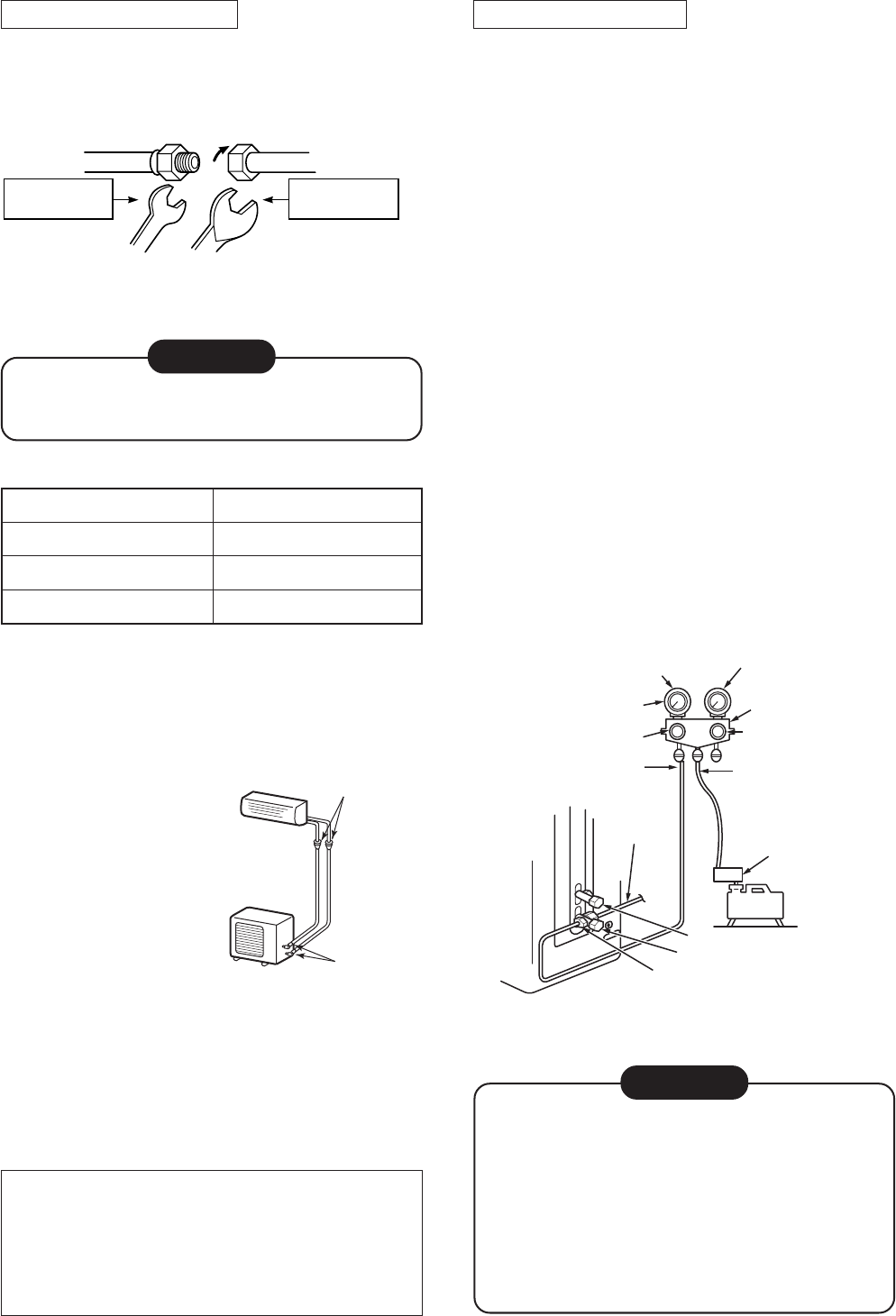
– 65 –
Tightening Connection
Align the centers of the connecting pipes and tighten
the flare nut as much as possible with your fingers.
Then tighten the nut with a wrench and torque
wrench as shown in the figure.
Fig. 10-4-7
CAUTION
• Do not apply excessive force.
Otherwise, the nut may break.
(Unit : N·m)
• Tightening torque for connection of flare pipe
The pressure of R410A is higher than R22.
(Approx. 1.6 times.) Therefore securely tighten the
flare pipes which connect the outdoor unit and the
indoor unit with the specified tightening torque
using a torque wrench.
If any flare pipe is
incorrectly connected,
it may cause not only
a gas leakage but also
trouble in the
refrigeration cycle.
Fig. 10-4-8
Half union
Flare nut
Externally
threaded side
Internally
threaded side
Use a wrench
to secure.
Use a torque wrench
to tighten.
Flare at
indoor unit
side
Flare at
outdoor unit
side
10-4-4. Evacuating
After the piping has been connected to the indoor
unit, perform the air purge.
AIR PURGE
Evacuate the air in the connecting pipes and in
the indoor unit using a vacuum pump.
Do not use the refrigerant in the outdoor unit.
For details, see the vacuum pump manual.
Fig. 10-4-9
CAUTION
• IMPORTANT POINTS FOR PIPING WORK
1. Prevent dust and moisture from entering the
pipes.
2. Tighten connections carefully (between
pipes and unit).
3. Evacuate the air in the connecting pipes
using a VACUUM PUMP.
4. Check for gas leaks at all connections.
Use a vacuum pump
Be sure to use a vacuum pump with counter-flow
prevention function so that oil inside the pump does
not flow back into the air conditioner pipes when the
pump stops. (If oil inside the vacuum pump enters
into the air conditioner circuit which uses R410A,
trouble with the refrigeration system may develop.)
1. Connect the charge hose from the manifold valve
to the service port of the gas side packed valve.
2. Connect the charge hose to the port of the
vacuum pump.
3. Open fully the low pressure side handle of the
gauge manifold valve.
4. Operate the vacuum pump to begin evacuating.
Perform evacuating for about 15 minutes if the
piping length is 20 meters (15 minutes for 20
meters) (assuming a pump capacity of 27 liters
per minute).
Confirm that the compound pressure gauge
reading is –101 kPa (–76 cmHg).
5. Close the low pressure valve handle of gauge
manifold.
6. Open fully the valve stem of the packed valves
(both sides of Gas and Liquid).
7. Remove the charging hose from the service port.
8. Securely tighten the caps on the packed valves.
Compound
pressure
gauge
Pressure gauge
Manifold valve
Handle Hi
(Keep full closed)
Charge hose
(For R410A only)
Vacuum pump
adapter for
counter-flow
prevention
(For R410A only)
Packed valve at liquid side
Packed valve at gas side
Service port
(Valve core (Setting pin))
Connecting
pipe
Handle Lo
Charge hose
(For R410A only)
-101kPa
(-76cmHg)
Vacuum
pump
Outer dia. of copper pipe
Ø6.35 mm
Ø9.52 mm
Ø12.7 mm
Tightening torque
14 to 18 (1.4 to 1.8 kgf•m)
33 to 42 (3.3 to 4.2 kgf•m)
50 to 62 (5.0 to 6.2 kgf•m)


















